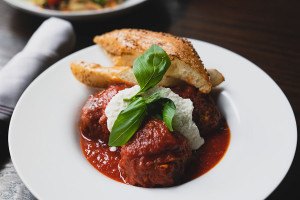Revisit: Banana Leaf in Chinatown
 My mother used to tell me that the best way to judge a cookbook is the least judgmental. In her opinion, all it took was a single recipe worth cooking to prove its value.
My mother used to tell me that the best way to judge a cookbook is the least judgmental. In her opinion, all it took was a single recipe worth cooking to prove its value.
Her point didn’t actually have anything to do with food. She was mainly trying to convince a haughty teenage brat that just because someone might not have much to say about political philosophy or the Fibonacci series or the gnostic Christians, that didn’t mean they weren’t worth talking to at all. (Yep, I was that guy and this actually needed to be spelled out for me. Now, of course, I am a delight.)
But still, there’s one Philadelphia restaurant that I’ve always looked at in this same way. The first time I went to Banana Leaf, it was for roti canai, and from that day forward it became the only thing I went for. Why mess with a good thing—especially one I’d been jonesing for for so long—by veering off into the rest of the menu?
Roti canai is a pretty simple snack. A highly elastic and prodigiously oily dough, stretched almost as thin as Saran wrap, is blistered on a hot griddle until it achieves that magic combination of pliancy and shattering crispiness that is a pizza lover’s holy grail, only more delicate. It’s served immediately, with a small bowl of a mild curry that must always include chicken and potatoes—though frequently just one or two small pieces of each, since its main function is to be dipping sauce.
Banana Leaf was where I first reconnected with roti canai about 10 years after falling under its spell in the Indian quarter of Kuala Lumpur, where it revolutionized my whole idea of a proper breakfast. The Arch Street restaurant’s rendition was more or less just as I remembered it, from the caramelized pockmarks on the stretchy bread to the boney chicken chunks in the clay-colored curry. Mission accomplished. Hold all calls, we have a winner.
In time, I would measure it against Penang’s version around the corner on 10th Street, which costs 20 cents more. The verdict? Penang’s curry was basically Banana Leaf’s plus 5 cents worth of unnecessary extra salt, and 15 cents toward a more urbane décor.
(At Penang, high ceilings overhang walls of fashionably weathered metal and artfully scarred concrete. Banana Leaf, on the other hand, looks like a Caribbean beach bar except with dim lighting and the palm trees hand-painted on one wall in bold primary colors. Both atmospheres are superior to the joints I remember in Malaysia, which too frequently screened Asian revenge flicks of astonishing violence during the lunch hour. Much as I love Malaysian food, some of the pleasure goes out of it when you’re forced to watch a wronged protagonist vanquish his nemesis by feeding him into an industrial meat grinder and literally making sausage out of his remains.)
I prefer both Penang’s and Banana Leaf’s roti canai to the versions at Spice 28 and Jane G’s, whose more refined, boneless dipping curries err on the side of sweetness and are more fragrant with coconut milk than the spice slurry that hooked me on this snack to begin with.
I know what you’re thinking. This guy is unhealthily obsessed with roti canai. And as far as Banana Leaf is concerned, you’re right. So recently I resolved to make a few visits where the rule would be that I could order anything but my favorite dish.
It wasn’t all that limiting, to be honest. Banana Leaf runs a pan-Asian smorgasbord that would take a month’s worth of dinners to fully sample—which makes sense, because Malaysia is a true melting pot of culinary influences. Dishes from pad Thai to Singapore noodles to Indonesian-style fried rice to Hainanese chicken are basically part of the national menu. Not to mention Cantonese dim sum and any number of Indian-style curries. (Roti canai—the c is pronounced like ch—is thought to be a linguistic reference to Chennai, the southeastern Indian port city from which many migrant laborers sailed to Malaysia during British rule.)
And whaddya know, Banana Leaf turned in solid renditions of virtually everything I tried. The Singapore-style vermicelli was fragrant with hint of curry but not nearly as oily as it too often is around town. Nasi lemak deployed the workhorses of the Indo-Malay archipelago—tiny chili-spiced anchovies, hard boiled eggs, chicken curry—around a coconut-sweetened mound of rice wafting the faintly floral scent of pandan leaves. Multidimensional and outstanding.
Indian mee goreng, loaded with tofu, shrimp, bean sprouts and scrambled egg, was a total surprise. If I had to speculate on the origins of this dish, I’d say that pad Thai recipe made its way to a chow mein master in Steinbeck country, who corrupted it with dried squid sauce. There wasn’t much I’d recognize as Indian about these stir-fried egg noodles, though it did remind me of the way Chinese fare is translated in “fancy” restaurants in Bangladesh. Choose your own random theory. And who really cares, when the flavors are this deep?
One day brought brief disappointment in the form of a crispy omelet studded with oysters, a few of which were offputtingly mealy. But against that was balanced a martabak dessert—a crepe stuffed with ground peanuts and corn kernels—in which sweetness and saltiness were perfectly balanced. There was also a pretty solid rendition of rojak, a sweet-sour fruit salad in which cubes of pineapple, semi-ripe mango, and cucumber are sugared and funkified with a high-umami blend of dark soy sauce and shrimp paste.
This is one of many dishes that carry a menu disclaimer: “Please ask server for advice before you order!” But that’s not exactly right. Here’s the way it actually works. You ask for the rojak. Your server looks you sternly in the eye and asks, “Rojak?” You then nod your head and say, “Yes, rojak,” whereupon the server officially shrugs off all responsibility for your potential gustatory dismay.
Rojak does indeed merit this order-it-twice confirmatory ritual. It’s not for everyone. But don’t let that same menu disclaimer steer you away from Banana Leaf’s fish-head curry. The palm-sized fish heads shed cheek meat, not pesky pin bones, so they’re easy enough to navigate. And anyway, the real treasures are the eggplant strips and okra pods soaking up the rich sauce, which is fantastically redolent of curry leaves. I’ve cooked this dish once in my own kitchen, from a recipe by Madhur Jaffrey. It’s a bit of a process even if you have the required umpteen spices on hand—but you only have to taste a good one to understand why Jaffrey says she spent 25 years trying to obtain her recipe from a favorite restaurant in Singapore’s Little India. I have exceedingly fond memories of mine, but that just may be because I invested too much effort in it not to view it through rose-tinted glasses.
But all you have to do at Banana Leaf is order it. Twice.
Banana Leaf [Official Site]


